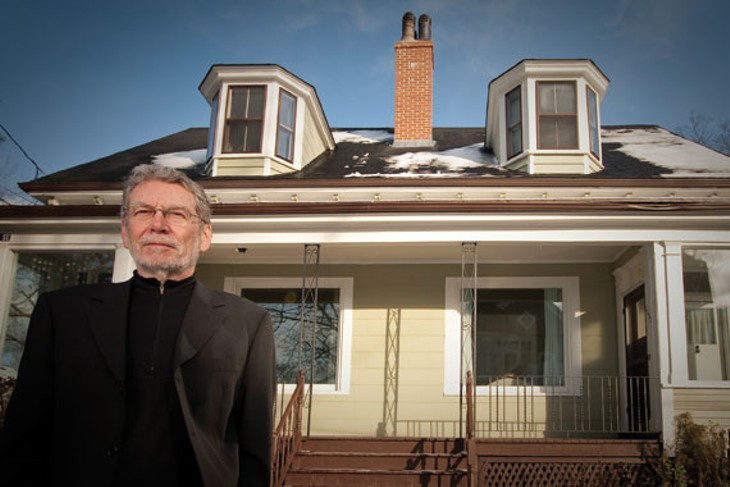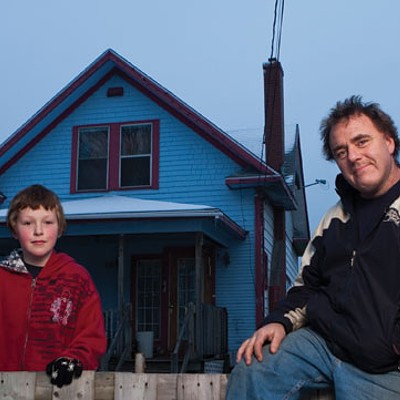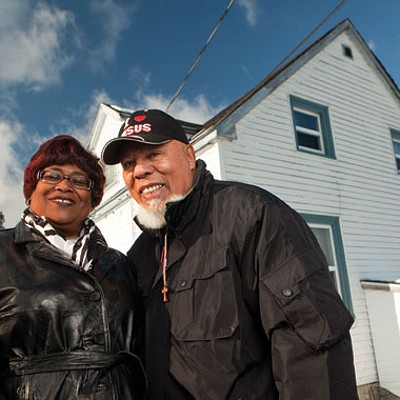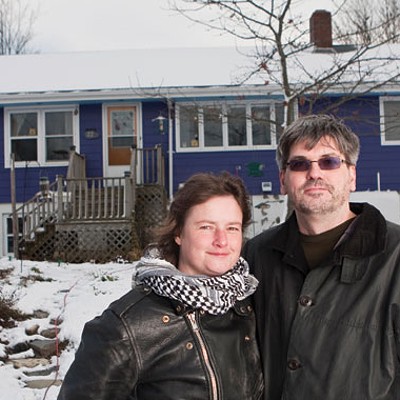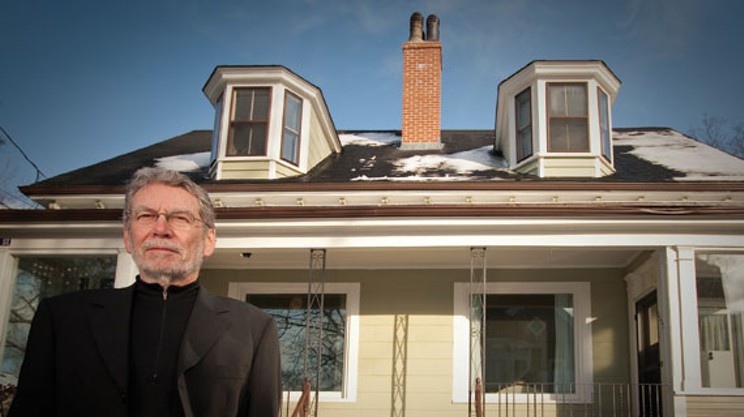One day last week I drove out to the Kingswood subdivision off Hammonds Plains Road, just beyond Bedford. Kingswood is the epitome of suburban sprawl; thousands of ritzy houses, some of them worth a million dollars or more, are plucked down on half-acre to two-acre lots along cul-de-sacs and roads stretching perhaps 10 kilometres into what was previously an undeveloped forest.
Kingswood is the kind of place frowned upon by urban planners and environmentalists. There are no schools, no grocery stores or other businesses, no fire stations, no parks. Nor are there bike lanes or sidewalks, and for good reason: It's pretty much impossible for residents to get anywhere without a car. And so most of the houses have two- or three-car garages. Some have four- or even five-car garages.
I went to Kingswood for research. I wanted to see how an arcane and complex proposal at City Hall, called "tax reform," plays out in the real world.
"Tax reform" does a lot of things. One thing it does is shift much of the residential property tax burden in HRM off homes in the urban core and onto homes out in the suburbs. A lot of urban homeowners think this is a fine idea. "I'm really, really, really tired of subsidizing the people who live in huge homes in the suburbs and drive two cars (more when their kids grow up)," explained one "tax reform" advocate in an email. "Most of these people make more money than I do. They are a drain on our collective resources... It costs as much as three times more to service a house in Kingswood or Fall River as it does a home that is on a 40×100-foot lot in the city."
So I went to check it out. At random, I picked a Kingswood street named Lake Mist Drive, and wrote down the addresses of all 10 houses on the street.For comparison's sake, I drove a little farther out Hammonds Plains Road, turned up Pockwock Road and followed it to the community of Upper Hammonds Plains. A sign greeted me: "Founded 1815: proud of our African heritage." The houses are small and weather-beaten, but well-maintained. They are mixed with a handful of home businesses, a car repair shop, a sawmill. Lawns are cut, ditches cleared. Emmanuel Baptist Church stands as sentry to a row of houses leading to the community centre. I selected 10 of the homes, and wrote down their addresses.
Later, using assessment information provided by the county and tax information provided by the city, I calculated what would happen to the two neighbourhoods under the "tax reform" proposal---the results are that residents living in suburban sprawl of Kingswood will be rewarded with a huge tax cut, while residents in the modest old black Loyalist community will see their taxes more than doubled (see the case study sidebar "Neighbouring suburban communities").
| Case study: Neighbouring suburban communities | Kingswood | Upper Hammonds Plains |
|---|---|---|
| Market value of average house | $542,020 | $107,380 |
| Current city and provincial tax | $5,908 | $876 |
| City and provincial tax under “reform” | $3,311 | $1,532 |
| City’s share of current taxes | $3,813 | $560 |
| City taxes under “tax reform” | $1,216 | $1,216 |
| Change in city tax | $2,597 lower (-68%) | increases $656 (+117%) |
| Note: The “average house” is an amalgamation of 10 houses. See story for methodology. | ||
Note that residents of both communities will pay the same city tax, $1,216, even though homes in one community are worth more than five times that of homes in the other.
City council may vote to begin the process to implement "tax reform" as soon as next Tuesday. If the plan is adopted, then, yes, some of the tax burden will be shifted off the urban areas and onto the suburbs, but the tax burden will be shifted within the suburbs as well, with the results in Hammonds Plains---high-priced homes getting tax cuts, modest homes seeing tax increases---repeated throughout HRM: Oceanfront mansions in Portuguese Cove get tax cuts, Spyfield residents get tax increases; high-end Cole Harbour houses get tax cuts, modest Forest Hills Park homes get tax increases; half-million dollar Bedford houses get tax cuts, Sackville tract homes get tax increases.
And that pattern would hold in urban areas as well: most homeowners on the peninsula get tax cuts, most Dartmouth homeowners and apartment dwellers get tax increases.
"Tax reform" is a good-government-sounding moniker designed to disarm opposition before it can materialize---how could anyone be against "reform"? As the proposal was being prepared for next week's council vote, city staff upped the terminology to an Orwellian extreme---documents given to councillors now flatly declare that the new tax proposal is "the best possible tax system."
But I've been reporting on the city tax issue for over two years and, recently, have conducted an extensive analysis of the "tax reform" proposal. From that work, I conclude that the words "tax reform" are a misnomer purposefully employed to mislead the public. To draw attention to that duplicity, I put "tax reform" in quotation marks.
In fact, my analysis of hundreds of homes and apartments throughout HRM shows that, far from being the "best possible tax system," the proposed tax system will slash millions of dollars off the tax bills of high-value properties and make up the lost revenue by increasing taxes on modestly priced houses. Further, contrary to the claims of "tax reform" supporters---and as the figures from Kingswood attest---the new system will reward suburban sprawl with tax breaks, and raise taxes for those living in compact, transit-friendly communities.
Worse still, "tax reform" appeals to the very worst of our instincts, putting narrow short-term self-interest of some individuals over the long-term good of the community as a whole.
"Tax reform" is a disaster in the making. And yet, just 10 days before Christmas, Halifax council is poised to make that disaster happen.
The road to ruin
Tax issues in HRM have always been complicated and contentious. HRM was created in 1996 by combining the cities of Halifax and Dartmouth, the town of Bedford and the mostly rural Halifax County. Those earlier jurisdictions had different levels of taxation, and provided different kinds and levels of services. Bringing them together into one system caused immense distrust, as residents of each former jurisdiction thought they were being taken advantage of by residents of the other jurisdictions.
Then the real estate market heated up. Increasing housing prices were matched by increasing tax assessments, and therefore increasing tax bills.
In south end Halifax, assessments rose 20 percent and more each year. Of course, as the value of their houses went up, south end residents became much wealthier as well: to the extent that they had equity in their houses, south enders could use their houses as collateral for loans to send their kids to college and start businesses, and their new high home values mean much larger future inheritances for those fortunate children. But those potential pluses were offset by an immediate minus---they had to pay the higher tax bill every year.
Many south enders felt that their larger tax payments were being used to subsidize services being delivered in the suburbs. Suburban residents didn't see it that way---thanks to the overheated housing market, suburban tax bills rose by large amounts every year too, albeit not quite so much as in the south end.
By 2005, the lingering distrust from amalgamation and the roaring real estate market prompted south end business people to call for "reform" on the entire tax system. Traditionally, property taxes in Canada are based on the value of one's home---the more expensive your house, the more you pay in taxes. The "reform" movement, however, wanted to ditch that system and replace it with a system that bases taxes not on the value of property, but rather on the cost of services.
Responding to those demands, on October 3, 2006, then-councillor Sheila Fougere, who represented the Connaught district, put forward a motion at council to "rebuild the foundations" of HRM's tax system. The motion was seconded by south end councillor Sue Uteck, and passed on an unrecorded voice vote. By January 2007 the Tax Reform Committee was formed, and given direction to explore how to switch from the existing assessment-based system to a fee-for-service based system. The switch was to be "revenue neutral"---that is, the new system was to bring in the same amount of total tax money as the existing system.
The effort got off to a bad start, with charges that city staff had rigged a series of "public consultation" meetings such that dissident voices were minimized and ignored, and that only a pre-approved "reform" agenda would move forward. "Those meetings were designed not to hear the public," Dartmouth councillor Gloria McCluskey declared at a city council meeting.
Still, the "reform" effort continued unabated. The Tax Reform Committee met over 30 times over the next two and a half years. Citizens for Halifax, a group formed by south end business people to influence the 2008 municipal elections, made "tax reform" one of its primary issues. And Fougere based her unsuccessful bid to replace mayor Peter Kelly in large part on a pledge to overhaul the tax system.
In May 2009, south end resident and professional pollster Don Mills published the results of a survey that asked respondents a single question: "Would you personally prefer property taxes to be based on property value assessments, or to be based on the cost of the services actually received by the property owner?" Those questioned were given no indication how such a change would affect their taxes, nor were they asked what would constitute a fair tax system, how the cost of services should be calculated or if issues of economic justice should enter the equation.
Like HRM's 2007 public consultation meetings, Mills' poll seemed designed to elicit a pre-determined response. Sure enough, fully 60 percent of respondents said they favoured a tax system based on the cost of services delivered, and the highest support---68 percent in Sackville---came from those living in an area that will see a tax increase under the "tax reform" proposal, suggesting that in fact respondents were not fully informed.
But Mills' poll is now held up by "reform" proponents as proof that residents want such a change.
| Case study: An extremely regressive tax system by design | David & Margaret Fountain, Young Avenue | Bill & Helen Zebedee, Clement Street |
|---|---|---|
| Market value of house: | $4,040,300 | $149,700 |
| Capped assessment: | $3,379,900 | $145,500 |
| Present tax system | ||
| City tax bill: | $28,695 | $1,235 |
| Tax per $100 of capped assessment: | 84.9 cents | 84.9 cents |
| Tax per $100 of market value: | 71 cents | 82.5 cents |
| Under “reform” proposal | ||
| Services charged: | all urban | all urban |
| Tax bill: | $1,316 | $1,316 |
| Tax per $100 of market value: | 0.03 cents | 87.9 cents |
| Note: Tax figures reflect only the city’s portion of property tax bills, and do not include the provincial and supplemental educations charges, which remain the same under both scenarios. |
The shell game
The Tax Reform Committee took seriously the charge to build a tax system based on the cost of services. But the "reform" movement has taken on a life beyond that mandate, and committee members, councillors and "reform" proponents in the community have added a number of levels of complexity to the argument---including environmental issues, a concern for low-income residents and the desire to reward those who, for lack of a better term, are considered to live virtuous urban lifestyles.
I have no way of judging the motives of "reform" proponents. No doubt many, perhaps most, are sincerely interested in building a fair tax system. But as I delved into this issue and explored the various arguments, it became increasingly clear that proponents' notion of fairness reflects their own biased perceptions.
Quite simply, for "reform" proponents a "fair" tax system means primarily one that reduces taxes on the owners of high-priced homes. Full stop.
The aim to reduce taxes on high-priced homes is the pea in a rhetorical shell game. All the other arguments---about the environment, about low-income assistance and so forth---are moves of misdirection to get the broader public to take its collective eye off the pea.
The immense complications of the arguments are themselves part of the set of feints used in the scam. But, if we examine them one at a time and look at what the "tax reform" proposal actually does, we can more clearly see what the true aim of the game is.
Hidden subsidies
According to Mills' poll results, people in HRM want property taxes "based on the cost of the services actually received by the property owner"---no one should be subsidized by someone else. But if we built such a system, the very first thing we'd have to do is to nearly triple property taxes.
As city budget documents show, if you add up all the residential taxes collected in HRM and compare it to the cost of all the services delivered to residential properties, you'd find that the costs are 2.7 times higher than the amount residents pay in taxes. The difference is made up by commercial property taxes.
So people on the Halifax peninsula who think they are subsidizing suburbanites are wrong---they aren't. It's Burnside and Bayers Lake industrial parks, and businesses in HRM generally, that are subsidizing suburbanites and peninsula residents alike.
Now, there's a good argument for having commercial taxes subsidize residential services---businesses can't make money without customers and workers who need municipal services. The Tax Reform Committee evidently found that argument convincing: the very first thing it did was to continue to accept the commercial tax subsidy for residential services. But keeping the commercial subsidy pulls the rug out from under the entire "reform" argument---citing "subsidies," "tax reform" proponents pit peninsula residents against suburbanites, but ignore the tax subsidies handed to all residents.
The assessment cap
As housing prices increased, the provincial government responded to complaints of high taxation by "capping" assessments---that is, no matter how much the market value of a house increases, its assessment for tax purposes won't increase more than a set percentage, until the house is sold or renovated, in which case it will be reassessed.
The assessment cap provides stability and predictability to residents' tax bills, and helps people from being priced out of their neighbourhoods by gentrification.
But "tax reform" proponents point at the assessment cap and say it illustrates how the present tax system is broken. Bruce Fisher, who heads the city's taxation division, uses the example of a street with five identical houses, each charged a different tax, with a range of 18 percent, thanks to the assessment cap.
Moreover, over time the assessment cap becomes "regressive"---it gives more relief to wealthy property owners than it does to owners of less pricy homes or to young people entering the housing market for the first time.
"Reform" proponents are right---the assessment cap can be regressive, but it also can be progressive, depending on circumstance. But let's look what happens under the "tax reform" proposal.
Consider two houses in urban HRM: philanthropists David and Margaret Fountain's Young Avenue mansion and government workers Bill & Helen Zebedee's modest house on Clement Street in Dartmouth. Both houses are now charged the same urban tax rate and receive all urban services.
The case study chart "An extremely regressive tax system by design" (above) shows how taxes are charged on their respective houses, both now and after "tax reform." The bottom line is that in terms of market value, the Zebedees now pay a tax rate that's 16 percent higher than the Fountains' tax rate; but under "tax reform," the Zebedees will pay a tax rate that's nearly 3,000 percent higher than the Fountains'.
"Tax reform" proponents criticize what can be a slightly regressive assessment cap system, only to replace it with an extremely regressive "reformed" tax system.
True costs
"Taxes and fees should be based on objective and factual information, and not subject to opinion or estimation," reads the final report of the Tax Reform Committee to council, and committee members like to portray their work as an exacting financial investigation of "true costs" of delivery of services to each individual property owner.
The claim is utter nonsense. It's easy enough to find the total cost of any given public service, but divvying up that cost between various property owners absolutely depends on opinion and estimation, every step of the way, and those opinions and estimations are changed, willy-nilly, for reasons of political expediency.
Consider solid waste collection. When the Tax Reform Committee started examining the delivery of that service, it used the existing districts employed by the solid waste department. The committee conducted a district-by-district examination, and allotted costs depending on the distance the trucks had to travel to the landfill, the availability of a transfer station and other factors.
I happened to stop by the committee meeting that day and later reported that under this system of analysis, the highest solid waste charges would be laid on the residents of North Preston. Subsequent to my reporting, the committee evidently decided that way of reckoning charges wouldn't fly politically, so they scrapped the entire analysis and instead took the total cost of services, subtracted out the commercial subsidy and divided the result by the number of properties, giving each property a flat $256 charge, no matter where the property is.
So which analysis is the "objective and factual"? Neither. Each is dependent on judgement calls---the very "opinion" the committee derides.
And that's the case for all the charges. The committee initially wanted to apply a transit charge if a property is within two kilometres of a bus stop---not 2.2 kilometres, not 1.8, and no consideration of hills. Why? Because that was the committee's opinion as to availability of transit. Council got a hold of that recommendation and changed it to one kilometre. Why? Because that was council's opinion. Yours might be something else, mine another entirely.
Same with recreation fees, sidewalk fees and so forth. (Under the existing system, there are just three assessment-based percentage fees---an urban rate covering most of the developed region, a rural rate and a suburban rate that covers a small area where the other two meet.)
"Tax reform" proponents sell their proposal as "objective," but because of the dozens, perhaps hundreds, of judgement calls involved, it is more arbitrary than the existing tax system.
Apartment taxes
Once you reject any notion of social justice or progressive taxation and ignore the biases involved in determining costs, "density bonuses" are a seemingly common sense idea---it costs less to provide service to those residents living closer together than to those living farther apart, and therefore fees for services should be reduced on those living in apartments and condos.
The "reform" proposal spells it out like this: apartment and condo dwellers all rely on the same fire hydrant, so rather than each unit being charged the same $116 fee homeowners are charged, a single $116 fee should be divided by the number of units in the building. Same thing with the $176 "local road" fee. Condo and apartment units will also be rewarded with a 40 percent discount on five other fees---local transit and sidewalks, regional roads and transit and a catch-all "regional services" fee. Only the recreation fee will be charged at a full per-unit rate equal to houses.
This complicated calculation means city taxes on high-end condos on the peninsula are cut drastically. The Bishop's Landing condo project, for example, is advertising its unsold units at $449,900 to $750,000. Under existing tax rules, the city tax for those units would range from $3,820 to $6,368; with "tax reform," each unit would have a city tax of just $732.
But that simply rewards people living low-impact urban lives, right? Well, apparently some low-impact urban dwellers are more worthy than others.
Consider apartment dwellers."Tax reform" proponents argue that the owners of apartment complexes pass property taxes along to residents in the form of rent, so if we lower the tax, it'll result in lower rents. I find that logic suspect, but certainly the reverse is true: if we raise taxes on apartment buildings, the extra charges will most definitely be passed along in higher rents.
On the peninsula, the proposed tax scheme charges some apartment owners a little more, others a little less. The real differences, however, come in Dartmouth: apartment buildings in Dartmouth will see a tax increase of hundreds of dollars per unit. (See case study sidebar.)
The same city council that is considering "tax reform" has, through the years, spent hundreds of millions of dollars developing the Burnside Industrial Park and Dartmouth Crossing, and as a result, thousands of workers have taken up residence in nearby apartment buildings in Highfield Park and the Dartmouth waterfront. These workers live in dense housing projects, have easy access to transit, can walk to work and services, et cetera---in short, they are living the low-impact urban life we supposedly want to encourage with "tax reform," and yet "tax reform" will surely cause their rents to go up.
| Case study: How “reform” taxes apartments | |
|---|---|
| Halifax Peninsula** | Dartmouth** |
| Quinpool Tower | Marine View Terrace |
| - $96 / unit | + $221 / unit |
| Fenwick Tower | Westgate Apartments |
| + $55 / unit | + $140 / unit |
| SouthPoint Apartments | 96 Highfield Park Drive |
| - $10 /unit | + $198 / unit |
| Ogilvie Apartments | 4 Franklyn Court |
| + $26 / unit | + $258 / unit |
| **Based on 2007 figures. |
Low-income relief
Three years and 30-plus meetings into their investigation, the Tax Reform Committee appears to have realized that the system they were proposing was going to hit poor people, and hit them hard. And so, the committee cobbled together a makeshift "plan" for low-income relief.
Presently, the city provides a tax rebate of up to $750 if household income is less than $27,000. The Tax Reform Committee's plan, such as it is, will increase the rebate to $1,000, plus a $100 per-child credit, and phase it out as household income approaches $36,000.
Thing is, while the committee spent months figuring the exact cost of, say, all the salaries and fuel for plowing away a snowfall, the low-income relief "plan" was so last-minute, an after-thought, truly, that no one has any idea what it would cost, or how to run it---in its report to council, the committee "hoped" the Canada Revenue Agency will administer it, but it's anyone's guess if such an arrangement is practical, or even legal.
How to pay for it? The committee proposes that "a surtax on the top five percent (or less) of homes would help ensure that higher income individuals bear more of the property tax burden. This would offset any increase in low income support." How much would the surcharge be? No one knows.
Regardless, suppose the entire "tax reform" plan is implemented, including the vague low-income relief plan. Now look at how taxes will change from our present system to the "reformed" system:
Very low income property owners: some additional relief.
Above relief level to median house value: increased taxes.
Median house value to very high value house: decreased taxes.
Very high value houses: vastly decreased taxes, plus an unknown surcharge.
"Tax reform" proponents celebrate an uncertain plan for some small amount of additional low-income relief, but their plan mostly gives millions of dollars of certain tax relief to median to high-end properties, paid for by owners of modestly priced houses.
everyone loses
The most stunning feature of the "tax reform" effort is that it has been taken seriously by our political leadership for three years---besides a few voices in the wilderness, no one much has had the courage to call the proposal what it is: a massive redistribution of wealth.
As my analysis shows, "tax reform" amounts to class war, rich against poor, better off against not-so-well off. That's not at all surprising; anyone who thought about the suppositions going into the process would have had to know what the results coming out would be---no matter how much you obscure it with rhetorical shell games and misdirection, changing an assessment-based tax system to a per-parcel fee-for-service system necessarily means that owners of lower priced properties will pay more, and owners of higher-priced properties less. It's simple arithmetic.
If councillors felt peninsula homeowners were paying too much tax, they could have tweaked the assessment charges in various areas---lower them a bit in the urban area, raise them in the suburbs. But instead they gave direction to the Tax Reform Committee to come up with a plan that necessarily shifts the tax burden within the suburbs to less-wealthy people generally, no matter where they live.
It's not, however, only a matter of economic justice. "Tax reform" is also bad for the city as a whole.
"In the short run ['tax reform'] is bad for poor people," Dalhousie economist Lars Osberg tells me. "But in the long run, it's bad for rich people too, because suddenly there's downward pressure on the quality of public services."
Osberg says with a service-based taxation system, the public will only support a level of services to the level affordable by the median wealth of the public---"it's a great way to mobilize taxpayers to demand fewer services," he says. "And that's not what you want to do when you're trying to get businesses and people to move to town."
"Everyone," says Osberg, "ends up worse for it."


